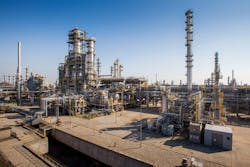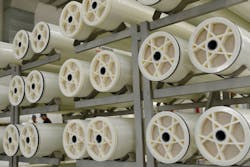Slovakian Oil Refinery Calls Foul Play on Membrane Fouling
Filtering water from the Danube river to supply boiler feed water, petrochemical company Slovnaft cleaned its reverse osmosis (RO) membranes every four-six weeks. After investigation, the economics and operation of the RO modules was improved at the refinery, reducing chemical frequency.
By Dr. Jens Lipnizki, Martin Krafzik and Alan Sharpe
The reverse osmosis facility at the Slovnaft oil refinery in Slovakia is one of the largest surface water treatment plants in Eastern Europe. The refinery produces a broad range of petrochemical raw materials and the company is a member of the Hungarian MOL Group.
The refinery water treatment facility produces fully demineralised water that is available as boiler feed water for water-steam circuits and other technical purposes. The raw water for the refinery is sourced from the Danube River and contains between 320 and 400 mg/l dissolved solids with seasonally fluctuating organic fractions. The river water can report electrical conductivity of up to 580 μS/cm. During treatment, it first undergoes chemical pre-treatment (coagulation, flocculation) and ultra-filtration (UF), before entry to the reverse osmosis (RO) system, which is divided into five separate lines, each equipped with 126 membrane elements.
The three-stage reverse osmosis demineralisation facility can produce up to 135 m3/hour of permeate, per line. The RO system has a permeate recovery of up to 85%. The maximum permeate conductivity as specified by the operator is 15 μS/cm, max. Post RO treatment, the permeate is sent to downstream mixed bed ion exchange resins for removal of any remaining ionic compounds.
At the beginning of the project, a projection of the RO plant was done with the LewaPlus design software to predict the performance of the plant. A high rejection membrane element type was selected since a conductivity of less than 10 μS/cm could be expected. Further and as additional benefit, this resulted in less of an ionic burden on the mixed bed ion exchange resins, lowering regeneration frequency.
Operational concerns
In December 2014, a total of 630 Lewabrane RO B400 HR high rejection membrane elements went into operation in the refinery complex’s water treatment plant. The calculated operational parameters were confirmed, and projected water quality was on the order of 5 μS/cm.
Another concern of refinery management was the reduction of cleaning chemicals around the RO system. The previous installed RO elements required a cleaning treatment every four to six weeks, usually prompted by an increase in feed pressure (and consequently, higher power consumption). To reduce this cleaning frequency required an investigation, and deeper understanding of the site-specific causes of the flux decline, and increase in pressure drop along the vessel.
[Photo: SLOVNAFT, a. s.]
A common cause for a higher applied feed pressure can be fouling, caused by organic settling, membrane scaling (caused by the precipitation of sparingly soluble salts), or biological growth. Generally, most of the bacteria and organics which cause fouling or biogrowth should be removed by the UF. However, it may happen that fiber breakage within some of the UF modules can lead to an increase of these foulants in the system.
Furthermore, membrane scaling is also a common cause of increasing feed pressures. The LewaPlus projection showed the possibility of Barium Sulfate and Calcium Carbonate scaling. The chemical addition prior to the RO system applies antiscalant; however, there is always the possibility of underfeeding.
Investigation
It is generally known that fouling will appear in the front end of an RO system, and that scaling usually appears at the tail end of the system (since the salt concentration at the tail end is more the four times higher compared to the feed inlet).
To investigate the problem of fouling and/or scaling, the operational parameters of the RO system were checked, and the data normalized against a specific reference condition.
Normalization programs are available from several RO suppliers. They are usually Excel spreadsheets which calculate the performance of an RO plant to a selected standard conditions. This data normalization helps the plant operator to judge whether the observed plant performance changes are due to a variation in the feed water conditions, like temperature or salt concentration, or whether the changes are due to fouling or scaling.
[Photo: LANXESS AG]
The Slovnaft refinery plant data analysis and normalization showed an increase in pressure drop in stage one, and an overall flux decline of the plant.
This investigation suggested that the primary reason for the loss of performance was from lead end fouling. To confirm this observation, a pressure vessel of stage one was opened, and the lead and the last element were removed for further investigation.
One fast and efficient method to evaluate the incidence of fouling is the measurement of the weight of an RO element. While a drip dry, new 8 inch diameter element has an average weight of around 16 kg, an increase in weight of more than one kg is a strong indication for fouling or scaling. In this case, the lead element was heavier than the last element, and a brown gelatinous film was observed on the feed side of the lead element. This was the first strong evidence for organic fouling and biogrowth in stage one.
Changes in chemical treatment
As a result of the normalization analysis and visual RO element inspection, Kurita was asked to propose an improved chemical treatment application to address the known fouling and biogrowth in the feed water to the RO system.
The existing Slovnaft refinery raw water treatment includes the dosing of organic coagulant, and dechlorination by dosing of a stabilised sodium bisulphite agent). The additional treatment steps proposed by Kurita included the following:
- Dosing of antiscalant to prevent scale formation on RO membranes
- Dosing of two different non-oxidizing biocides for prevention of biofouling
- Periodic cleaning and disinfection of RO membranes.
A Kurita software program was used to select a suitable antiscalant product which has shown excellent results not only in calcium carbonate and calcium sulfate scaling prevention, but also highly effective for barium salts precipitation.
The biocide injection was applied as a complex chemical treatment program. In addition to chlorination, the process includes two non-oxidizing biocides (with different active components) which are dosed intermittently into the feed water tank.
After discussion with specialists of the main technology dept. of Slovnaft, it was decided that the biocides were to be dosed alternately over a three month period.
It is now known that the RO membranes are fouled with both soft and hard deposits on the membrane surface.
These deposits (or foulants) decrease the permeate flow and salt rejection, and increase the differential pressure and energy consumption. This situation, if untreated, often results in the necessity of membrane replacement, but can be remedied by improvements in cleaning protocols.
In this case, a specially developed Cleaning In Place (CIP) program for the RO membranes was applied for the removal of both inorganic and organic fouling materials. A two-step CIP program was applied using the following conditions:
- Alkaline CIP, using a special chemical composition and procedure. A combination of three products is used - surfactant, dispersant, plus pH adjustment. The main purpose is to remove the colloidal matters, iron and organic substances, bacteria, algae, etc.
- Acidic CIP, the main purpose is to remove scale deposits from membrane surface. Based on collaborative work with Lanxess, a product with a special combination of active ingredients was developed and has been successfully applied.
As the result of the customised CIP procedure, and application of the new, complex chemical treatment process described above, the cleaning period of the Lanxess RO membranes was prolonged to three to four months from the previous four to six weeks with the prior RO elements installed at the refinery.
Conclusion
An RO system is judged by its efficiency and reliability. The new installed elements showed a rejection (permeate quality) above the expectations. At start up, the applied feed pressure was in the predicted range but a slightly increase in pressure drop could be observed after some weeks. To understand these subtle changes in operating performance, an investigation of the RO system was necessary. In this case, normalization of the operating data, and RO element autopsy were employed to determine the causes of lower operational performance. This approach confirmed that biogrowth and organic fouling was reducing the efficiency and reliability of the RO system.
An improved and customised chemical treatment and CIP cleaning protocol was applied at the refinery. The initial results are quite encouraging with respect to cleaning frequency.
Less frequent cleaning cycles, and less regenerant chemicals consumption for the downstream ion exchange mixed-bed are the reward for the application of these new protocols. In the final analysis, these improvements should result in an economic and ecologic benefit for the refinery.
It is acknowledged that these improvements are initial performance results as the implementation of the process changes is only quite recent. The final judgement as to the impact of these improvements on RO membrane life and economic benefit to the refinery will need to wait until sufficient run time of the RO system has occurred, and improved performance is seen to be sustainable.
Dr. Jens Lipnizki is head of technical marketing membrane for LANXESS, Martin Krafzik is from Kurita Europe and Alan Sharpe (LANXESS Sybron). For more information on the project, email: [email protected].
More Water & WasteWater International Archives Issue Articles


